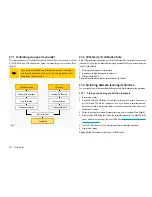
Safety Instructions |
15
>
Do not expose rechargeable batteries to fire, as there is a risk of explosion!
>
Keep rechargeable LiPo batteries away from children. Store rechargeable batteries in
a dry, cool place.
>
If a rechargeable battery is deformed or damaged during a crash, it must no longer be
used. The same applies for “swollen” rechargeable batteries, or rechargeable batteries
with other visible deformation or leaks. Do not attempt to charge such rechargeable
batteries! Danger of fire and explosion!
>
Dispose of such rechargeable batteries in an ecologically sound fashion.
>
The general hazard notices for handling batteries and rechargeable batteries also
apply to rechargeable LiPo batteries.
15.5.2.2 Total discharge
>
Since discharging below 3.0 V per cell would lead to permanent damage of the
rechargeable battery pack, this total discharging is to be prevented as far as possible.
>
For safety reasons, programmable cruise controls/flight control systems should be set
in such a way that the undervoltage detection has already responded before a voltage
of 3.0 V per cell is reached (e.g. 3.2 V). Alternatively, optical undervoltage displays are
also recommended.
15.5.2.3 Correct dimensioning
>
As the current drawn rises, the battery pack warms and the usable capacity is lowered.
The ideal operating temperature during discharge is between
+20
and
+40 °C
and must
not exceed
+60 °C
even under extreme load.
>
The maximum short-time discharge current is stated in the technical data sheets or can
be read directly from the battery pack. The value “C” always refers to the capacity value
of the respective battery pack.
Example:
A battery pack with a capacity of 2100 mAh and ”20 C” can be dis-
charged with 2100 mA x 20 = 42 A maximum.
>
However, the maximum permissible continuous current is clearly lower. If there are no
precise manufacturer’s specifications, the battery pack should not be discharged with
more than approx. 50 % of the maximum permissible surge current over a long term.
15.6 Miscellaneous
>
Consult an expert when in doubt about operation, safety or connection of the device.
>
Maintenance, modifications and repairs are to be performed exclusively by an expert
or at a qualified shop.
>
If you have questions which remain unanswered by these operating instructions,
contact our technical support service or other technical personnel.
Summary of Contents for NovaX 350
Page 1: ...88012RC ArF 88014RC RtF NovaX 350 Operating instructions M1...
Page 2: ...2 EVER WONDERED WHAT INNOVATION LOOKS LIKE NovaX 350...
Page 21: ...Dimensions 21 22 2 Long legs 283 mm 283 mm 250 mm 241 mm 130 mm 2 0 3 m m 3 4 7 m m...
Page 27: ...Calibration 27 2 1 90 90 90 1 2 3 4 5 6 Fig 6...
Page 49: ...49...
Page 50: ...50...
Page 51: ...51...
Page 52: ...52 www rclogger com...
















































